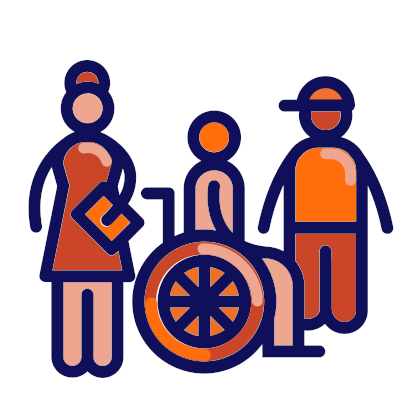Improving well-being at school

Since well-being has many facets, improving students’ well-being in schools requires a whole-school approach, involving both teachers and parents.
Schools should provide lessons focused on the responsible use of the Internet, the need to adopt a healthy lifestyle and how to prevent or cope with health problems, in collaboration with those involved, including health and social services, local authorities and civil society organisations.
Facts & figures
About 60% of school students report getting very tense when they study.[1]
Just over 60% of girls and 40% boys say they feel very anxious about doing tests at school, even when they are well prepared.[2]
Over 70% of parents say they would choose to send their children to a school with below-average exam results if students were happy there.[3]
What is well-being?
Well-being is the experience of health and happiness. It includes mental and physical health, physical and emotional safety, and a feeling of belonging, sense of purpose, achievement and success.
Well-being is a broad concept and covers a range of psychological and physical abilities. Five major types of well-being are said to be:
- Emotional well-being – the ability to be resilient, manage one’s emotions and generate emotions that lead to good feelings
- Physical well-being – the ability to improve the functioning of one’s body through healthy eating and good exercise habits
- Social well-being – the ability to communicate, develop meaningful relationships with others and create one’s own emotional support network
- Workplace well-being – the ability to pursue one’s own interests, beliefs and values in order to gain meaning and happiness in life and professional enrichment
- Societal well-being – the ability to participate in an active community or culture.
Overall well-being depends on all these types of functioning to an extent.[4]
“Having meaning and purpose is integral to people’s sense of well-being. Well-being involves far more than happiness, and accomplishments go far beyond test success.”[5]
Why is well-being important at school?
Well-being is important at school because schools have an essential role to play in supporting students to make healthy lifestyle choices and understand the effects of their choices on their health and well-being. Childhood and adolescence is a critical period in the development of long-term attitudes towards personal well-being and lifestyle choices. The social and emotional skills, knowledge and behaviours that young people learn in the classroom help them build resilience and set the pattern for how they will manage their physical and mental health throughout their lives.
Schools are able to provide students with reliable information and deepen their understanding of the choices they face. They are also able to provide students with the intellectual skills required to reflect critically on these choices and on the influences that society brings to bear on them, including through peer pressure, advertising, social media and family and cultural values.
There is a direct link between well-being and academic achievement and vice versa, i.e. well-being is a crucial prerequisite for achievement and achievement is essential for well-being. Physical activity is associated with improved learning and the ability to concentrate. Strong, supportive relationships provide students with the emotional resources to step out of their intellectual ‘comfort zone’ and explore new ideas and ways of thinking, which is fundamental to educational achievement.
Well-being is also important for developing important democratic competences. Positive emotions are associated with the development of flexibility and adaptability, openness to other cultures and beliefs, self-efficacy and tolerance of ambiguity, all of which lie at the heart of the Council of Europe Reference Framework of Competences for Democratic Culture.
What are the challenges?
One of the challenges of trying to promote young people’s well-being in school is the multi-faceted nature of well-being. There are a number of different types of well-being, all of which need to be promoted to some extent to create an overall sense of well-being in a person. So, it is not possible to improve students’ well-being at school through single interventions or activities. Rather it requires the development of a ‘culture’ of well-being throughout the whole school and the active involvement of the whole staff, teaching and non-teaching, which can be difficult to achieve.
The promotion of well-being may sometimes appear to conflict with other school priorities, such as academic standards. Unreasonably high expectations, a regime of constant testing or an over-emphasis on the importance of academic performance may actually undermine student well-being.
In many cases schools do not have the freedom to make the changes to school life which might most benefit student well-being. They may have little control, for example, over formal examinations and tests, the content of curricula, the length of the school day or the physical school environment.
Nor have schools control over the many out-of-school influences on student well-being. What happens in the home and the family, local communities or social media can have as much, if not more, influence on student well-being as anything in school.
Finally, developing a sense of well-being in students is made all the more difficult when school staff themselves do not have a positive sense of well-being. Well-being at work is strongly related to stress. Stress at work is related to workload, quality of professional relationships, level of autonomy, clarity about one’s role, availability of support and the opportunity to be involved in changes which affect one’s professional life. High levels of stress can lead to demotivation, lack of job satisfaction and poor physical and mental health, which has a knock-on effect on students’ own well-being.
How can schools get active?
Addressing student well-being at school begins with helping students feel they are each known and valued as an individual in her or his own right, and that school life has a meaning and purpose for them. This can be achieved in a variety of small ways, the cumulative effect of which can have a very powerful influence on students’ sense of well-being. These include:
- providing opportunities for all members of the school community to participate in meaningful decision-making in school, e.g. through consultations, opinion surveys, referenda, electing class representatives, student parliaments, focus groups, in-class feedback on learning activities, and an element of student choice in relation to topics taught and teaching methods used;
- developing a welcoming environment where everyone at school can feel supported and safe through access to meaningful activities, e.g. clubs, societies, interest groups and associations dealing with issues of concern to young people, including health;
- taking steps to reduce the anxiety students feel about examinations and testing through the introduction of less stressful forms of assessment, e.g. formative assessment, peer assessment and involving students in the identification of their own assessment needs;
- using teaching methods that contribute to a positive classroom climate and well-being, e.g. cooperative learning, student-centred methods, self-organised time, outdoor activities;
- finding curriculum opportunities to talk about well-being issues with students, e.g. healthy eating, exercise, substance abuse, positive relationships;
- integrating democratic citizenship and education for intercultural understanding into different school subjects and extra-curricular activities, e.g. openness to other cultures in Religious Education, knowledge and critical understanding of human rights in Social Science, empathy in Literature;
- introducing student-led forms of conflict management and approaches to bullying and harassment, e.g. peer mediation, restorative justice;
- improving the physical environment of the school to make it more student-friendly, e.g. new furniture and fittings, carpeted areas, appropriate colour schemes, safe toilet areas, recreational areas;
- encouraging healthier eating by providing healthy options in the school canteen, e.g. avoiding high amounts of sugar, saturated fats and salt;
- working with parents to enhance students’ achievement and sense of purpose in school, e.g. on healthy food, safe internet use and home-school communications.
Individual initiatives like these can be brought together at the whole-school level through a policy development process which ‘mainstreams’ well-being as a school issue. This means giving attention to the potential effects of new policies on individual well-being - of students, teachers and others. Addressing student well-being at school always goes hand in hand with action to protect the health and well-being of teachers and other staff at school.
[1] OECD (2017). PISA 2015 Results (Volume III), p.40. Students’ Well-Being. Paris, France: OECD Publishing.
[3] Cowburn & Blow, ‘Wise up - Prioritising wellbeing in schools’
[4] Psychology Today, January 2019.
[5] Hargreaves & Shirley (2018), ‘Well-being and Success. Opposites that need to attract’.
 Resources on Improving well-being at school
Resources on Improving well-being at school
 Related schools projects
Related schools projects
Address: Elaiones, Pylaia, p.c. 555 35
Country: Greece
Project: 10+1 reasons for being grateful every day
 Working language during the project:
Working language during the project:
- English &
French (for other projects)
 Themes of the Council of Europe campaign “FREE to SPEAK, SAFE to LEARN - Democratic Schools for All” covered:
Themes of the Council of Europe campaign “FREE to SPEAK, SAFE to LEARN - Democratic Schools for All” covered:
- Making children’s and students’ voices heard
- Improving well-being at school
 Competences from the Reference Framework of Competences for Democratic Culture (CDC) addressed and where / how they were integrated:
Competences from the Reference Framework of Competences for Democratic Culture (CDC) addressed and where / how they were integrated:
- Openness to cultural otherness and to other beliefs, world views and practices
During the project’s presentation, the students expressed curiosity about and interest in discovering and learning about the views, the beliefs, the values and the practices of their peers. The mosaic created during the presentation helped the students develop emotional readiness and stability. Additionally, the students were able to relate to others who are perceived to be different from oneself - Autonomous learning skills
Every student was able to select appropriate methods for accomplishing his/her task. The project gave students the opportunity to search, locate and gain access to various information resources, advice or guidance, which is required to address these needs. These resources included personal experiences, interactions and discussions with others in a digital classroom but also in a “special environment created because of the pandemic- their house”. They shared opinions and world views and they acquired skills, especially in the digital media (graphic design, image processing). - Knowledge and critical understanding of the self
During the lockdown the students had the opportunity to think and recognize in a critical way their feelings, especially the things that made them grateful. This established a positive and constructive basis for the well-being of the students. - Empathy- Respect
This project, carried out in a very difficult period for students of this age, led to an understanding that students from different backgrounds have the same psychological needs. The students showed respect towards the different forms of expression and the different communicative conventions (both verbal and non-verbal) that were created during this procedure (both online as well as after the lockdown).
 Target group age range:
Target group age range:
- 11 - 15
 Level of education:
Level of education:
- Lower secondary education
Short description of the project:
10+1 reasons for being grateful every day is a project carried out in Arsakeio High school of Thessaloniki during the COVID-19 lock-down (from March until May 2020). Its aim was the creation of a digital collage by each student showing the reasons for being grateful, namely the persons, spaces, activities, things in general each student considers important in his/her life. Acknowledging all the benefits each student enjoys in his/her life results in feelings of gratefulness, self-esteem, self-efficiency, joy and strength for the confrontation of problems such as those of the lock-down, but also other problems in general. Additionally, the diversity of the reasons for gratefulness presented by each student reinforces the recognition and the acceptance of each person as a unique human being, worthy of other people’s respect and appreciation, whereas the reasons’ uniformity highlights all children’s common needs. In conclusion, this project aims at strengthening each student’s feeling of individuality, but also the feeling of belonging to a community.
The students’ voices are heard one after the other, their collages are presented all together, creating a colourful mosaic of images that depicts their world. A world that accepts, respects and depends on each one of its members, while at the same time constitutes a compact and coherent core, which emits its wonderful and life-giving qualities in the broader society.
The students were trained in graphic design and image processing, in order to compose images, photographs, graphic elements and text in a single collage that would present artistically each student’s unique realm.
The composition procedure involved several team presentations of each student’s work-in-progress, followed by discussions and feedback provided by the students themselves. The positive and stimulating environment in the digital classrooms, created by several discussions, resulted in strengthening each student’s feeling of self-confidence and sense of freedom to reveal information about him/herself to his/her classmates, thus strengthening their relationships.
 Aims/objectives
Aims/objectives
The objectives of the “10+1 for being grateful everyday” program are:
- …to promote a common understanding among students.
- …to develop empathy skills.
- …to give the opportunity to express different values, opinions and attitudes.
- …to improve students’ confidence and self respect.
- …to improve communication among students.
- …to enhance partnership and cooperation.
- …to support/boost students’ mental health and wellbeing during lockdown.
 Expected results/outcomes
Expected results/outcomes
As a result of the project, students learnt that gratitude allows them to celebrate the present, it dispels negative emotions, builds more resilience and cultivates a higher sense of self worth.
 Changes
Changes
After getting into the spirit of feeling gratefulness, participants were more motivated to seize the day. They became friendlier, kinder, more enthusiastic and expressive. They were more connected to and satisfied with their friends, school, community and even themselves. Additionally, they felt optimistic and used the feeling of being grateful to form new social relations. Lastly, teachers and parents observed that participants were more competent in dealing with daily problems.
 Challenges you faced
Challenges you faced
At the beginning of the program, we were concerned that some students might hesitate to express their opinions and expose their identity. However, we were pleased to find out that all participants were overjoyed that they could share thoughts with their peers.
 Time-frame of the project:
Time-frame of the project:
March 2020- May 2020
 Council of Europe materials on citizenship and human rights education used while preparing or implementing your practice:
Council of Europe materials on citizenship and human rights education used while preparing or implementing your practice:
- Reference Framework of Competences for Democratic Culture
- All Different – All Equal
- Compass
- Compasito







